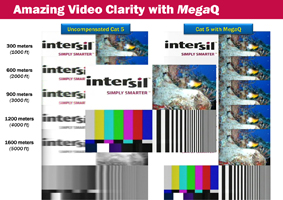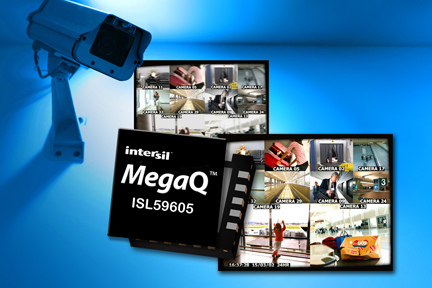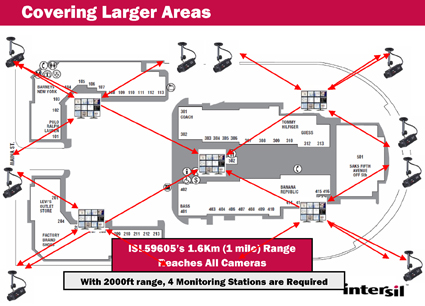The challenge in transmitting video over distances is to get more information down longer cables faster. The longer distance video images must travel, the longer the cable must be. As cables lengthen, resolution is lost. These losses affect any type of transmission, but they are definitely most complicated at the higher data rates required by video. Techniques like equalization can help, but distance remains a challenge once information needs to move more than about 300 meters, or about 1,000 feet. For example, Ethernet in all its forms is only specified to go 100m (300ft). HDMI on an entertainment center is usually limited to a few meters unless a special cable is added. USB peripherals need to be within five meters a desktop PC to avoid losses. Analog security cameras, an increasingly popular and necessary application today for video, need to be within 300 meters of the console or the picture will suffer. These distances are not long enough for larger commercial buildings, security system applications, and other innovative uses for video in locations like airports, malls, stadiums, and automated factories. Video feeds from security systems in these kinds of facilities need distances much greater than in the past. Solutions The circuitry used to compensate for losses in a system, called equalizers, ensures that a signal coming out of the cable is exactly the same as the signal going in. The equalizer reverses losses and makes the output signal "equal" to the input signal. But cable length challenges remain. Equalization is just one way to deliver video accurately at longer distances, and it is better. Briefly, the other way is called pre-emphasis and the concept is based on using a higher voltage at the input to boost a signal at the source end with the assumption that more �information' will get to the furthest end of the system. To send a video signal down a mile of Cat 5 cable (24AWG twisted pair) is a challenge. Assuming 70dB cable attenuation at the critical video frequency, the required voltage at the beginning of the cable is a massive 3000 volts. That requirement ends up driving 30 amps into a very thin 24AWG twisted pair, which generates too much heat for the wires. Equalization is better because it is designed not to ramp voltage but instead to restore a signal degraded by cable length. For example, a signal needs a 70dB boost at high frequencies (the complete video signal takes a bandwidth of 5MHz or so) to deliver an adequate picture. That's still a factor of 3000, but now it is a gain factor instead of a voltage. Instead of forcing the source end of the cable to a very high voltage, equalization allows the signal to drop by 70dB, then amplifies the signal to boost it at the output with no stress to the cable and no potential for melting wires. A single stage equalizer can boost about 14dB, so if five are placed in a row, it generates the required 70dB of boost.

This solution is generally reliable, but there remains the threat that �noise,' or unwanted interference from electronic amplifiers, can swamp the video signal. Noise at the input of a circuit receives the same gain as the signal. To get acceptable video at the far end, equalizer noise must be at least 30dB (about 32 times) smaller than the video at the input to the equalizer. The dynamic range amounts to about 100dB, or about 100,000:1. MegaQ from Intersil (ISL59601, ISL596502, ISL59603, ISL59604, ISL59605) Intersil's MegaQ (ISL5960x) represents the application of advanced analog digital techniques to the problem of long cable equalization. It provides automatic sensing of video signal parameters and implements appropriate correction and equalization. MegaQ requires no user intervention in most applications and provides full bandwidth video output from a variety of cable types and lengths. Prior to the technology breakthrough in MegaQ, customers were limited to cable distances around 600 meters (2000ft). To send a video image further, a repeater station was required. This repeater represents another piece of equipment installed in the signal path, which adds additional costs into every long distance cable run. With MegaQ these larger installations can be achieved more easily, with less infrastructure and therefore reduced system cost. Whether the installation is large or small, the many automatic features in MegaQ greatly improve the quality and speed of installation. Because the MegaQ equalizers are adaptive, they automatically compensate the video signal to equalize the signal regardless of the length of cable being used (up to one mile, or 1600m); from a practical standpoint, this means that installers are not making adjustments that affect the quality of the video image. In addition, MegaQ automatically adapts to different types of cables, different types of video (NTSC, PAL, Color or Monochrome) and can automatically compensate for a twisted pair cable that has been inverted, saving valuable time for the installer. New "MegaQ" Adaptive Composite Video Equalizer First Ever Device to Deliver Picture-Perfect Images Up to 1.67km (1 mile) Over Cat 5 or Coaxial Cable Intersil Corporation has launched the industry's most innovative and versatile single channel adaptive equalizers for delivering composite video through cables. The Intersil "MegaQ" devices are designed to automatically equalize video over the popular and inexpensive Cat 5 cable as well as the more traditional coaxial cable. The MegaQ devices deliver outstanding composite video images at distances over five times those currently possible, with a maximum length of 1 mile or 1.67 kilometers.

These industry-best adaptive equalizers enable cameras or video displays to be placed in remote areas, eliminating the need for repeaters and distribution hubs, making the family ideal for the security market or any application using composite video. In addition to its remarkable performance, the MegaQ family requires no user interaction or adjustments to get the best performance, so video quality is no longer dependent on the installer.

Adaptive equalization takes place on the receive end of the signal chain where images are viewed, so a MegaQ equalizer can easily be added to existing installations, instantly improving image quality. MegaQ does not require any active circuitry at the transmission (or camera) end, so cameras already at remote sites or mounted on buildings or poles do not need to be retrofitted. The ISL59605 compensates for high frequency cable loss up to 60dB at 5MHz, as well as source amplitude variations up to �3dB. Every device is automatically compatible with NTSC and PAL, color and monochrome, with no hidden caveats. Inputs are AC-coupled and internally DC-restored to maximize common mode noise rejection. The output can drive 2VP-P into two source-terminated 75? loads. The equalizers require a single +5V supply and consume only 500mW. The MegaQ family continuously monitors the cable characteristics and compensates for long-term cable aging. Several optional locking modes are available to help maintain lock in noisy environments. An optional serial interface on each device provides signal monitoring. Pricing and Availability The ISL59601, ISL59602, ISL56903, ISL59604, and ISL59605 are available now in compact 4x4 20-lead QFN packages. Pricing for 1,000-piece units starts at $6.12 for the ISL59601; $7.96 for the ISL59602; $10.40 for the ISL59603; $13.85 for the ISL59604 and $18.98 for the ISL59605. To support the MegaQ family, two demonstration boards are also available. The ISL5960X-EVALZ is a compact, stand-alone demonstration board solution available at $250.00. The ISL5960X-SPI-EVALZ provides user access to the SPI interface for signal monitoring and is available for $350.00. About Intersil Intersil Corporation is a leader in the design and manufacture of high-performance analog, mixed signal and power management semiconductors. The Company's products address some of the fastest growing markets within the communications, computing, consumer and industrial industries. For more information about Intersil or to find out how to become a member of the Company's winning team, visit the Company's website and career page at: www.intersil.com